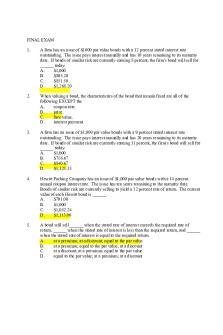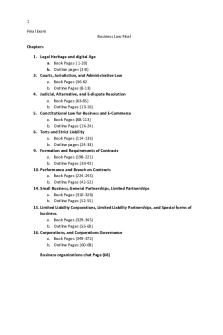Final exam thames business math PDF

| Title | Final exam thames business math |
|---|---|
| Course | Analytical Chemistry 2 |
| Institution | Mapua University |
| Pages | 5 |
| File Size | 86 KB |
| File Type | |
| Total Downloads | 38 |
| Total Views | 166 |
Summary
Download Final exam thames business math PDF
Description
FINAL EXAM 1.
A firm has an issue of $1000 par value bonds with a 12 percent stated interest rate outstanding. The issue pays interest annually and has 10 years remaining to its maturity date. If bonds of similar risk are currently earning 8 percent, the firm's bond will sell for ______ today. A. $1,000 B. $805.20 C. $851.50 D. $1,268.20
2.
When valuing a bond, the characteristics of the bond that remain fixed are all of the following EXCEPT the A. coupon rate. B. price. C. face value. D. interest payment.
3.
A firm has an issue of $1,000 par value bonds with a 9 percent stated interest rate outstanding. The issue pays interest annually and has 20 years remaining to its maturity date. If bonds of similar risk are currently earning 11 percent, the firm's bond will sell for ______ today. A. $1,000 B. $716.67 C. $840.67 D. $1,123.33
4.
Hewitt Packing Company has an issue of $1,000 par value bonds with a 14 percent annual coupon interest rate. The issue has ten years remaining to the maturity date. Bonds of similar risk are currently selling to yield a 12 percent rate of return. The current value of each Hewitt bond is ______. A. $791.00 B. $1,000 C. $1,052.24 D. $1,113.00
5.
A bond will sell ______ when the stated rate of interest exceeds the required rate of return, ______ when the stated rate of interest is less than the required return, and ______ when the stated rate of interest is equal to the required return. A. at a premium; at a discount; equal to the par value B. at a premium; equal to the par value; at a discount C. at a discount; at a premium; equal to the par value D. equal to the par value; at a premium; at a discount
6.
If a corporate bond is issued with a coupon rate that varies directly with the required return, the price of the bond will A. equal the face value. B. be less than the face value. C. be greater than the face value. D. be greater than or less than the face value depending on how interest rates vary.
7.
Calculate the value of a $1,000 bond which has 10 years until maturity and pays quarterly interest at an annual coupon rate of 12 percent. The required return on similar-risk bonds is 20 percent. A. $656.77 B. $835.45 C. $845.66 D. $2,201.08
8.
Interest rate risk and the time to maturity have a relationship that is best characterized as A. constant. B. varying. C. direct. D. inverse.
9.
For an investor who plans to purchase a bond maturing in one year, the primary consideration should be A. interest rate risk. B. changes in the risk of the issue. C. yield to maturity. D. coupon rate.
10.
The yield to maturity on a bond with a price equal to its par value will A. be less than the coupon rate. B. be more than the coupon rate. C. always be equal to the coupon rate. D. be more or less than the coupon rate depending on the required return.
11.
What is the approximate yield to maturity for a $1000 par value bond selling for $1120 that matures in 6 years and pays 12 percent interest annually? A. 8.5 percent B. 9.4 percent C. 12.0 percent D. 13.2 percent
12.
Mugwump Industries has issued a bond which has a $1,000 par value and a 15 percent annual coupon interest rate. The bond will mature in ten years and currently sells for $1,250. Using the approximation formula to calculate the yield to maturity (YTM) of this bond results in a YTM of A. 11.11 percent.
B. C. D.
15.00 percent. 27.78 percent. 42.22 percent.
13.
What is the yield to maturity, to the nearest percent, for the following bond: current price is $908, coupon rate is 11 percent, $1,000 par value, interest paid annually, eight years to maturity? A. 11 percent. B. 12 percent. C. 13 percent. D. 14 percent.
14.
Al is trying to decide which of two bonds to buy. Bond H is a 10 percent coupon, 10year maturity, $1,000 par, January 1, 2000 issue paying annual interest. Bond F is a 10 percent coupon, 10-year maturity, $1,000 par, January 1, 2000 issue paying semiannual interest. The market required return for each bond is 10 percent. When using present value to determine the prices of the bonds, Al will find that A. there is no difference in price. B. the price of F is greater than H. C. the price of H is greater than F. D. he needs more information before determining the prices.
15.
What is the current price of a $1000 par value bond maturing in 12 years with a coupon rate of 14 percent, paid semiannually, that has a YTM of 13 percent? A. $604 B. $1090 C. $1060 D. $1073
16.
If a firm's variable costs per unit increase, the firm's operating breakeven point will A. decrease. B. increase. C. remain unchanged. D. change in an undetermined direction.
17.
If a firm's sale price per unit decreases, the firm's operating breakeven point will A. decrease. B. increase. C. remain unchanged. D. change in an undetermined direction.
18.
If a firm's fixed financial costs decrease, the firm's operating breakeven point will A. decrease. B. increase. C. remain unchanged. D. change in an undetermined direction.
19.
The firm's operating breakeven point is the point at which A. total operating costs equal total fixed costs. B. total operating costs are zero. C. EBIT is less than sales. D. EBIT is zero.
20.
Noncash charges such as depreciation and amortization _____ the firm's breakeven point. A. do not affect B. overstate C. understate D. decrease
21.
A firm has fixed operating costs of $525,000, of which $125,000 is depreciation expense. The firm's sales price per unit is $35 and its variable cost per unit is $22.50. The firm's cash operating breakeven point in units is A. 23,330. B. 32,000. C. 42,000. D. 52,000.
22.
Which one of the following is (are) considered as limitations of breakeven analysis? A. It assumes that the firm faces linear, or nonvarying, sales revenue and total operating cost functions. B. It is difficult to break semivariable costs into fixed and variable components. C. It has a short-term time horizon. D. All of the above.
23.
A major assumption of breakeven analysis and one which causes severe limitations in its use is that A. fixed costs really are fixed. B. total revenue is nonlinear. C. revenues and operating costs are linear. D. all costs are really semi-variable.
24.
The per dollar contribution toward fixed operating costs and profits provided by each dollar of sales is the A. profit margin. B. contribution margin. C. expense ratio. D. fixed coverage ratio.
25.
A firm has fixed operating costs of $10,000, the sale price per unit of its product is $25, and its variable cost per unit is $15. The firm's operating breakeven point in units is ______ and its breakeven point in dollars is ______. A. 250; $ 6,250
B. C. D.
400; $10,000 667; $16,675 1,000; $25,000
26.
A firm has fixed operating costs of $150,000, total sales of $1,500,000, and total variable costs of $1,275,000. The firm's operating breakeven point in dollars is A. $150,000. B. $176,471. C. $1,000,000. D. $1,425,000.
27.
A firm has fixed operating costs of $253,750, a sales price per unit of $100, and a variable cost per unit of $65. The firm's operating breakeven point in dollars is A. $725,000. B. $700,000. C. $906,250. D. $390,385.
28.
One function of breakeven analysis is to A. create profits. B. describe leverage. C. evaluate the profitability of various sales levels. D. determine the amount of financing needed by the firm.
29.
The preferred approach to breakeven analysis for the multiproduct firm is the A. breakeven point expressed in units. B. breakeven point expressed in dollars. C. cash breakeven point. D. overall breakeven point.
30.
A firm has fixed operating costs of $25,000, a per unit sales price of $5, and a variable cost per unit of $3. What is its operating breakeven point if it desires net operating income of $10,000, not $0 (zero)? A. 12,500 units B. 15,000 units C. 17,500 units D. 25,000 units...
Similar Free PDFs

Final exam thames business math
- 5 Pages

MATH 32 Final Exam
- 4 Pages

Discrete Math Final Exam
- 2 Pages

Math 124 Final Exam
- 6 Pages

MATH 1401 final exam
- 11 Pages

Final-exam-review - math
- 16 Pages

Math 1001 Final Exam
- 7 Pages

Final Exam MATH 2552
- 13 Pages

Final 2017 - Math 1600 exam
- 15 Pages

Math 19500 Final Exam Practice
- 1 Pages

Business LAW Final EXAM
- 70 Pages

MATH 113 Final Exam Review
- 8 Pages

Math 1111 Final Exam Review
- 27 Pages

MATH 1280 Stats Final Exam
- 14 Pages
Popular Institutions
- Tinajero National High School - Annex
- Politeknik Caltex Riau
- Yokohama City University
- SGT University
- University of Al-Qadisiyah
- Divine Word College of Vigan
- Techniek College Rotterdam
- Universidade de Santiago
- Universiti Teknologi MARA Cawangan Johor Kampus Pasir Gudang
- Poltekkes Kemenkes Yogyakarta
- Baguio City National High School
- Colegio san marcos
- preparatoria uno
- Centro de Bachillerato Tecnológico Industrial y de Servicios No. 107
- Dalian Maritime University
- Quang Trung Secondary School
- Colegio Tecnológico en Informática
- Corporación Regional de Educación Superior
- Grupo CEDVA
- Dar Al Uloom University
- Centro de Estudios Preuniversitarios de la Universidad Nacional de Ingeniería
- 上智大学
- Aakash International School, Nuna Majara
- San Felipe Neri Catholic School
- Kang Chiao International School - New Taipei City
- Misamis Occidental National High School
- Institución Educativa Escuela Normal Juan Ladrilleros
- Kolehiyo ng Pantukan
- Batanes State College
- Instituto Continental
- Sekolah Menengah Kejuruan Kesehatan Kaltara (Tarakan)
- Colegio de La Inmaculada Concepcion - Cebu

